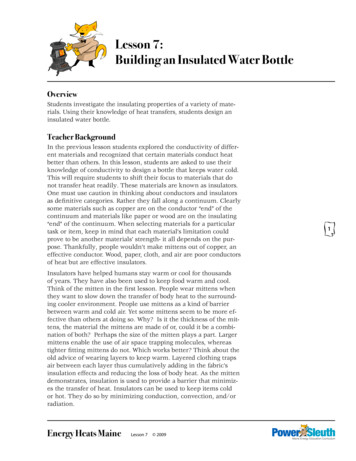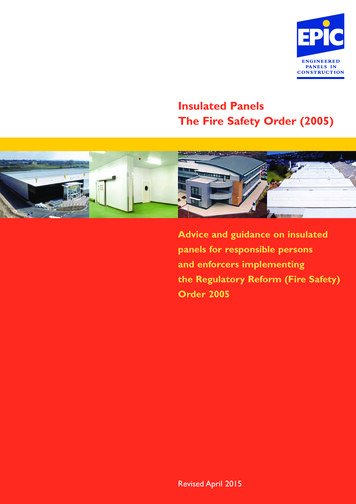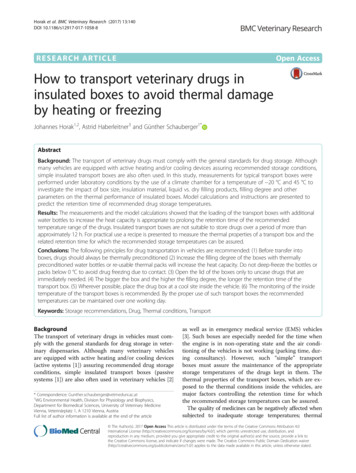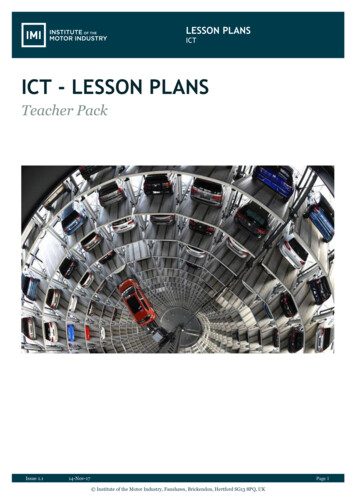
Transcription
Lesson 7:Building an Insulated Water BottleOverviewStudents investigate the insulating properties of a variety of materials. Using their knowledge of heat transfers, students design aninsulated water bottle.Teacher BackgroundIn the previous lesson students explored the conductivity of different materials and recognized that certain materials conduct heatbetter than others. In this lesson, students are asked to use theirknowledge of conductivity to design a bottle that keeps water cold.This will require students to shift their focus to materials that donot transfer heat readily. These materials are known as insulators.One must use caution in thinking about conductors and insulatorsas definitive categories. Rather they fall along a continuum. Clearlysome materials such as copper are on the conductor “end” of thecontinuum and materials like paper or wood are on the insulating“end” of the continuum. When selecting materials for a particulartask or item, keep in mind that each material’s limitation couldprove to be another materials’ strength- it all depends on the purpose. Thankfully, people wouldn’t make mittens out of copper, aneffective conductor. Wood, paper, cloth, and air are poor conductorsof heat but are effective insulators.Insulators have helped humans stay warm or cool for thousandsof years. They have also been used to keep food warm and cool.Think of the mitten in the first lesson. People wear mittens whenthey want to slow down the transfer of body heat to the surrounding cooler environment. People use mittens as a kind of barrierbetween warm and cold air. Yet some mittens seem to be more effective than others at doing so. Why? Is it the thickness of the mittens, the material the mittens are made of or, could it be a combination of both? Perhaps the size of the mitten plays a part. Largermittens enable the use of air space trapping molecules, whereastighter fitting mittens do not. Which works better? Think about theold advice of wearing layers to keep warm. Layered clothing trapsair between each layer thus cumulatively adding in the fabric’sinsulation effects and reducing the loss of body heat. As the mittendemonstrates, insulation is used to provide a barrier that minimizes the transfer of heat. Insulators can be used to keep items coldor hot. They do so by minimizing conduction, convection, and/orradiation.Energy Heats MaineLesson 7 2009G1
What properties make “good insulators?” Density plays a role.The further apart atoms are from each other, the more difficult itis for a heat transfer to take place. Because of this gases such asair, which molecules are spread far apart, make better insulatorsin general than liquids. The molecules of liquids are further apartthan solids making liquids in general better insulators than solids.By removing the atoms altogether (as in a vacuum), heat transferby means of conduction and convection is eliminated, but radiation comes into play.Heat transfer by radiation presents other considerations. Ever notice that many thermoses are made of reflective or shiny material?If a thermos is full of hot soup the shiny surface inside the thermoswall reflects the heat (infrared radiation) of the hot soup back tothe hot soup keeping the soup hotter for longer periods of time.Why are people urged to wear white clothing in the summer as opposed to dark colors? White reflects heat and light better than darkcolors and keeps the person cooler. Dark colors absorb light andheat more than light colors. Many items, such as home insulation,auto shades, space suits, hot/cold food bags, ice cream containers,etc. are also reflective and are used as insulators for that reason.G2The focus of this lesson for students is, “How can knowledge ofconductors and insulators be used to keep ourselves and differentitems warm or cool?3Key Ideas Different materials conduct thermal energy at different rates.Metals conduct heat rapidly. Other materials, such as plastic andwood, do not conduct heat rapidly. Knowledge of thermal conductivity differences is used to developproducts and technologies that allow people to safely andefficiently use heat. Depending on how they are used, materials can be used to slowor accelerate heat transfers.Lesson GoalsStudents will: recognize that a thermal conductor is a material that allows heatto readily transfer through it. recognize that heat is conducted at different rates throughdifferent materials. use their knowledge of heat transfers to design an insulatedwater bottle.Energy Heats MaineLesson 7 2009
Vocabulary(thermal) conductor: a material that conducts heat well andquickly; metal is a good thermal conductor.(thermal) insulator: a material used to reduce the rate of heattransfer.Preparation D etermine whether students will be responsible for bringing ininsulating materials or whether the teacher will gather the investigation materials. C ollect empty sports drink plastic bottles or other uniformlysized/shaped bottles. Each student will need one bottle. Have afew extra bottles on hand – one will be used as a “control.” C onsider how often temperature in the insulator bottles will betaken – some prefer every 3 minutes; others take an initial temperature at the beginning of the class and another at the end ofthe class.SafetyThe first part of this investigation requires the use of hot tap waterby students. Double check the temperature of the school’s hotwater to make certain students would not be accidentally burned ifwater contacts their skin.Energy Heats MaineLesson 7 2009G3
MaterialsG4ItemFor student experiment: 4-500 mL containers (beakers) of hot tapwater (Alternatively, could use insulatedtake out coffee cups with covers- thiseliminates the need to cover cups withplastic wrap.) 4 thermometers plastic wrap to cover containers and“contain” insulating material aroundbottles.Stopwatches or access to timer that displays minutes: secondsA variety of insulating materials: Aluminum foil Packing peanuts Fiber fill Shredded or crumpled newspaper Sawdust Sand Plastic bags Cloth (samples of cotton, wool)Gallon size resealable bagLarge storage tube(38 quart or suitable size)Hot tap water in storage tubThermos and/or insulated hot/coldfood bag – now available in manygrocery stores (prop)Chilled (refrigerated) water(enough for students to fill insulated bottles)Quantity1 per group of4 studentsScientist’s NotebookStudent Handout 7.1:Insulation Investigation Planning Guide1 per student1 per studentStudent Handout 7.2:Sample Data Tables and Sample GraphsStudents Handout 7.3: Keeping It Cool:Building an Insulated Water BottleEnergy Heats MaineLesson 7 20091 per class or1 per student groupEnough for class(Students could beasked to bring itemsfrom home.)1 per student pair1 per class1 per class1 per class1-2 gallons per class
Time Required: 3-6 sessionsSession 1:Session 2:Session 3:Session 4:Session 5:Session 6: iscuss insulation and plan in groupsDConduct investigationGraph and discussPlan for new insulation challenges; peer reviewCarry out the insulation challengesDiscuss results; The Mitten Problem ReduxConnection to Maine Learning Results: Parametersfor Essential Instruction (MLR), and National ScienceEducation Standards (NSES), and Benchmarks forScience Literacy (BSL) D escribe how heat is transferred from one object to another byconduction, convection, and/or radiation. MLR D3(6-8) j H eat moves in predictable ways, flowing from warmer objects tocooler ones until both reach the same temperature. NSES B (5-8) T hermal energy is transferred through a material by the collisionsof atoms within the material. Over time, the thermal energytends to spread out through a material and from one materialto another if they are in contact. Thermal energy can also betransferred by means of currents in air, water, or other fluids.In addition, some thermal energy in all materials is transformedinto light energy and radiated into the environment by electromagnetic waves; that light energy can be transformed back intothermal energy when the electromagnetic waves strike anothermaterial. As a result, a material tends to cool down unless someother form of energy is converted to thermal energy in thematerial. BSL 4E/M3* (6-8) D esign and safely conduct scientific investigations includingexperiments with controlled variables. MLR B1(6-8) b E xplain why it is important to identify and control variables andreplicate trials in experiments. MLR C1(6-8) b D esign a solution or product. MLR B2 (6-8) b C ommunicate a proposed design using drawings and simplemodels. MLR B2 (6-8) c E valuate a completed design or product. MLR B2(6-8) e S uggest improvements for their own and others’ designs andtry out proposed modifications. MLR B2(6-8) fEnergy Heats MaineLesson 7 2009G5
Teaching The LessonEngage1Engage in introductory discussion about insulators.Open the lesson by noting that there are a number of situations inwhich the transfer of heat is problematic. People have developed anumber of ways to influence and regulate heat transfers by puttingtheir knowledge of how heat is transferred into action. They develop technologies that are effective in slowing the rate of transferor speeding up the rate of transfer. Let’s consider a few examples:Note: Consider gathering a few of the items mentioned below asprops for the discussion.G6 When it’s cold outside, what do you put on before going out? (Peoplemight wear a sweater or jacket, mittens) Why? Where is heatcoming from and where is it going? (Clothing insulates or slowsdown the transfer of heat from your body to the environment.) Do you think some clothing material helps keep a person’s heat fromtransferring better than others? (Students may suggest down, wool,fleece are insulating materials.) What do you use to take a pan of brownies out of a hot oven? (Peopleprotect their hands with an oven mitt or use a potholder.) Why?(The mitt prevents heat from being transferred from the hot panto your hand.) Ask students to suggest other devices they may have used or arefamiliar with that decrease or increases the rate of heat transfers.As students make their suggestions, discuss how heat is beingtransferred in each of the situations. (Cookware, firefighter’sclothing, wetsuits, machinery, etc.) How do people influence the heat transfers that occur in their homesand other buildings? In other words, what features do buildings havethat aid in temperature regulation? (People have heating and cooling systems of various sorts; insulation, windows, etc.)Explain that in this lesson students will be exploring insulators.Discuss with students what an insulator is, how it is different thana conductor, and ask students to give examples of insulators theyare familiar with. Students can think of insulators as materials thatslow the rate of heat transfer.Energy Heats MaineLesson 7 2009
Note: As students share what they know about insulating materials listen carefully to gauge whether students (still) believe thatcertain materials are inherently warm or cold. As this lesson proceeds, consider having students monitor the temperature of the insulating materials throughout the investigation (beginning, middle,end) to help students overcome this persistent idea.Alternately, divide students into groups of 4 and have them discusswhat they think will make a good insulator and why. Assign eachstudent the task of bringing in one of the items chosen for testing.Have groups plan what each student is bringing in so there are norepeat test materials within a group. Wood shavings, scarves, dirt,mud, dog hair, horse hair, wool, aluminum foil, toilet paper, andmittens are items students may choose to test. Discourage studentsfrom bringing in housing insulation. Eliciting the help of studentsin gathering materials piques students’ curiosity.Explore2Introduce the investigation.Explain that they will be planning and carrying out an investigation that explores the effectiveness of different types of materialsas insulators. Each student group of 4 will select 3 different materials to insulate containers filled with 500 mL of hot tap water todetermine which material has the best insulating properties. Onecontainer will serve as the control.Alternately, student groups can be (randomly) assigned insulation types to test as a way to make certain all insulation types areinvestigated.A variety of insulating materials should be available to students.Label each type. As students begin planning their investigation,encourage students to examine the different materials beforedeciding which materials their group would like to compare andbefore students make their predications.Distribute a copy of Student Handout 7.1: Insulation Investigation Planning Guide to each student. Allow students time to plantheir investigation using the guide. Direct students to record theirinvestigation plan in their scientists’ notebooks. Assist students asneeded. Note any common questions or difficulties that arise asstudents are planning and address appropriately in the discussionthat follows.Energy Heats MaineLesson 7 2009G7
3G8Review investigation plans.Before students begin, discuss the following: What variables are there in this investigation? (insulation materials) Which variables are you changing? (Students should only changethe different insulation materials- everything else should remainthe same in order for this to be a fair test: the container size,the amount of water, starting temperatures, taking temperaturereadings – all should remain constant.) How will you know if the material is having an effect- slowing downthe transfer of energy? (Students should recognize that a controlcontainer is needed; one container that has not been insulatedshould be monitored as well and will be used for comparison.) How often should temperature readings be taken during theinvestigation? (Recommend that students take readings every1-2 minutes.) How will you record your observations? (tables, graphs, observations) Alternatively, guide students in creating data tables andgraphs or provide students with the sample data table found onStudent Handout 7.2: Sample Data Table and Sample Graphs.Note: Make certain that students have made a prediction prior tobeginning their investigation. Give students a few minutes to makenecessary edits to their plans.4Conduct the investigation.Instruct students as to how to obtain the necessary investigationmaterials including how to safely access and measure hot tap water. Demonstrate for students how to unwrap or nest the insulatingmaterials around the outside of the container. As students conducttheir investigation, circulate among students, monitor studentprogress and ask questions that focus on student understanding.Reflect And Discuss5Energy Heats MaineReview, analyze, and discuss data.Ask students to create a graph of their findings and write a conclusion supported with evidence in their scientists’ notebooks. Gatherstudents together for a scientists’ meeting. Discuss the following: What conclusions did you make? Were there differences in data? Were there differences in the way different groups conducted theirinvestigation? Based on the data, which insulation slowed the transfer of heatthe most? Which insulation slowed the transfer of heat the least?Lesson 7 2009
W hat is the source of heat in the investigation? (Discuss the ideathat the insulator is not a heat source. Be sure students recognizethat insulators slow heat transfers. Ask students what temperature the insulating material is and/or monitor the temperatureof the insulating materials as well to help students overcome theidea that some materials are inherently “hot” or “cold.”) I f you could do the investigation again, what materials would you try? W hat new questions do you have about insulators and heat transfers6Present new insulation challengeShow students a thermos and/or an insulated (hot/cold food)bag that are available at many grocery stores. Ask students whatthey think these items would be used for. Students may not havethought about the possibility of using them to keep food like icedtea or frozen food cold on one day and then the next day use themto keep something like soup or pizza hot. How is this possible? Passaround the items and allow students to closely examine the materials from which these are made. While the items are being passedaround the class, ask students to write about how they think theseitems can be used to keep things both cold and hot in their scientists’ notebooks.Once the items have been examined, ask if students think the insulating materials they investigated earlier could also be used to keepsomething cold.Give each student a copy of Student Handout 7.3: Keeping it Cool:Building an Insulated Water Bottle and review the criteria. Makesure the students know ahead of time that their insulated waterbottles will be placed in water – that might affect the choice of insulating materials. Explain that students will be working in pairs toplan, construct, and test an insulated water bottle. Ask student tobring their materials to school and consider giving students a20 minute time limit to construct their bottles.7Constructinsulated bottles.Give students 20 minutesto construct their insulated water bottles following their plans. Studentsshould wrap each bottlein plastic wrap to keepchosen insulation snug.Then put the bottle inplastic bag.Energy Heats MaineLesson 7 2009G9
89G10Energy Heats MaineExamine peer’s designs.Ask students to place their insulated water bottle on their desksor in a designated area. Give each student pair a pad of stickynotes. Allow students a few minutes to examine the bottles created by their peers. As they examine the designs of their peers,ask students to write down a constructive comment, a suggestion,or question about the design and stick it on the desk next to thebottle. After students have had a chance to examine the differentdesigns, share some of the comments that have been written onthe notes with the class. Be sensitive to students’ feelings whensharing comments and consider paraphrasing, posing commentas a question, or eliminating comments if they are inappropriate.Note: Take time to discuss the purpose of share ideas and theneed to maintain respect for each other while writing and readingcomments.Test insulated water bottles.Fill a container, large enough for all insulated bottles to fit inside,with hot tap water. The hot water tub will simulate a hot day. Haveeach pair fill their water bottle with a uniform amount of refrigerated (chilled) water. Fill an extra bottle with the same amount ofrefrigerated temperature water to serve as the control. Have students take and record the starting temperature of the refrigeratedwater. Have students test their insulated bottles by placing theirbottles in the hot water tub.After 3 minutes have students check and record the temperatureand again every 3 minutes. Alternatively, have students take aninitial temperature at the start of class and then take the temperature at the end of class. Have students calculate the total temperature change in their scientists’ notebooks.Prepare and post a class data chart on the board, on an overhead,or a computer data collection program. Have students add theirdata to the class data chart.Lesson 7 2009
1011Review findings and reflect on designs.Review class data and discuss findings with students as before.Consider asking students to reflect upon some or all the followingprompts before meeting. W hat conclusions did you make? D escribe how your bottle work compared with others in your class. B ased on the class data, which types of insulated bottle designsslowed the transfer of heat the most? W hy did you design the bottle the way you did? Use your knowledgeof heat transfers to explain. I f you could redesign your bottle, what changes would you makeand why? W hat new questions do you have about insulators and heat transfers?Revisit The Mitten Problem Redux.Provide each student with Student Handout 7.4, The Mitten ProblemRedux. Ask students to complete the task. Collect and reviewstudents’ ideas.G11Energy Heats MaineLesson 7 2009
ExtensionsStudent may: investigate early refrigeration methods (“ice box”). Ice housesand root cellars were commonplace in earlier times. View how ice was harvested from Maine lakes by the Sebago IceCompany. This 5 minute narrated clip, Ice Harvest, has unevenbut discernable audio. Ice Harvest Sampler, 1930s-1940s, footageprovided by Northeast Historic Film, www.oldfilm.org To viewmovie clip go to: d.aspx?objectId 6-2400 click on “Moving Image” view How Do You Keep Lemonade Cool?, a video clip adapted fromFETCH! which shows two cast members teaming up to take ona design challenge: Make a lemonade stand that keeps lemonadecool and is sturdy and transportable. Teachers may like to show thisto students in conjunction with their insulated bottle 6 vid lemonadestand/ read A Chilling Story: How Things Cool Down (1991) by Eve andAlbert Stwertka. This book describes cooling by heat transfer,cooling by evaporation, and cooling by expansion. It also haschapters describing how refrigeration and air conditioning works.G12Connection to Maine AgenciesA Maine Energy Education Program (MEEP) is a no cost resourcefor schools and teachers in Maine. MEEP representatives and willcome to interested schools, free of charge, to guide and support theconcepts in lesson and have programs that supplement concepts inthis lesson: School Energy Efficiency Investigation: Students use tools tosee how their school uses energy and where energy is wasted.Tools include an infrared thermometer, a temperature/humiditydatalogger, a light meter and a Kill A Watt meter. Students canthen make recommendations on how energy can be conserved intheir school. This project can be combined with the GreenhouseGas Surveys being offered by Maine DEP.More information can be found on the MEEP website:www.meepnews.org/classroomactivities.For schools in Aroostook County, a Maine Public Service (MPS)representative will come to interested schools, free of charge, toguide and support concepts developed in this lesson. A descriptionof programs is available at www.mainepublicservice.com. Clickon the education section of the site. To schedule a presentationcontact Nancy Chandler at 207.760.2556 or nchandler@mainepublicservice.com.Energy Heats MaineLesson 7 2009
Online References and ResourcesLesson adapted from Utah Education Network in partnershipwith the Utah State Office of Education and the Utah System ofHigher Education, Insulation n/preview.cgi?LPid 21569Chicago Science Group. (2007). Science Companion: Energy.Lesson 7: Building a Better Water Bottle. USA: Chicago ScienceGroup and Pearson Education, Inc.http://www.sciencecompanion.comHouck, C. (2000-5). Insulators, Conductors, and Energy Transfer.Beacon Learning Center, U.S. DOE Technology InnovationChallenge Grant.How Stuff Works: How Thermoses (Vacuum Flasks) nation of Insulation R-values: http://www.school-forchampions.com/science/thermal insulation.htmArticle: Gas Filled Cold Weather Clothing Wins Awards BYUstudent’s clothing invention: http://inventorspot.com/articles/gas filled clothing wins awards 13558Article: Surviving Olympic HeatClimaCool /20040630/Feature1.aspEnergy Heats MaineLesson 7 2009G13
heat more than light colors. Many items, such as home insulation, auto shades, space suits, hot/cold food bags, ice cream containers, etc. are also reflective and are used as insulators for that reason. The focus of this lesson for students is, "How can knowledge of conductors and insulators be used to keep ourselves and different











